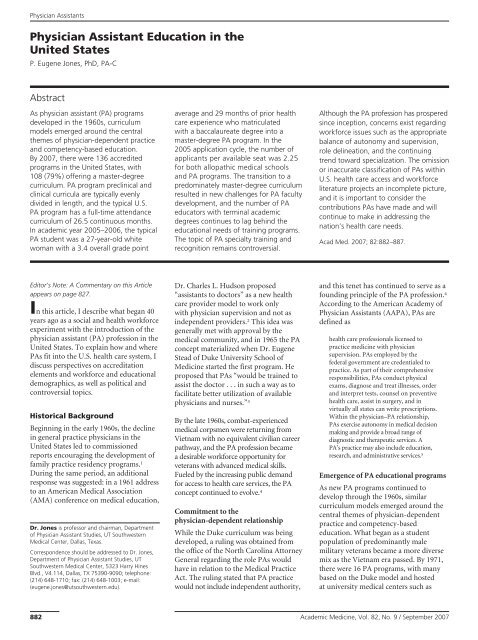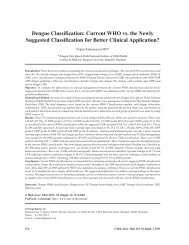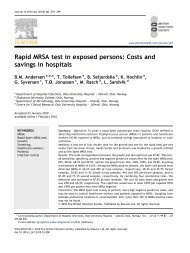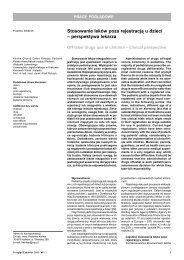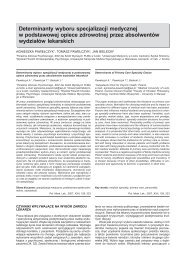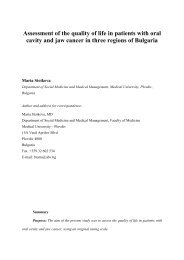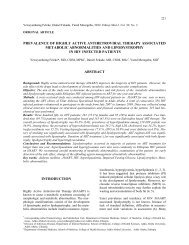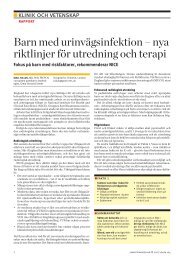Physician Assistant Education in the United States
Physician Assistant Education in the United States
Physician Assistant Education in the United States
You also want an ePaper? Increase the reach of your titles
YUMPU automatically turns print PDFs into web optimized ePapers that Google loves.
<strong>Physician</strong> <strong>Assistant</strong>s<br />
<strong>Physician</strong> <strong>Assistant</strong> <strong>Education</strong> <strong>in</strong> <strong>the</strong><br />
<strong>United</strong> <strong>States</strong><br />
P. Eugene Jones, PhD, PA-C<br />
Abstract<br />
As physician assistant (PA) programs<br />
developed <strong>in</strong> <strong>the</strong> 1960s, curriculum<br />
models emerged around <strong>the</strong> central<br />
<strong>the</strong>mes of physician-dependent practice<br />
and competency-based education.<br />
By 2007, <strong>the</strong>re were 136 accredited<br />
programs <strong>in</strong> <strong>the</strong> <strong>United</strong> <strong>States</strong>, with<br />
108 (79%) offer<strong>in</strong>g a master-degree<br />
curriculum. PA program precl<strong>in</strong>ical and<br />
cl<strong>in</strong>ical curricula are typically evenly<br />
divided <strong>in</strong> length, and <strong>the</strong> typical U.S.<br />
PA program has a full-time attendance<br />
curriculum of 26.5 cont<strong>in</strong>uous months.<br />
In academic year 2005–2006, <strong>the</strong> typical<br />
PA student was a 27-year-old white<br />
woman with a 3.4 overall grade po<strong>in</strong>t<br />
average and 29 months of prior health<br />
care experience who matriculated<br />
with a baccalaureate degree <strong>in</strong>to a<br />
master-degree PA program. In <strong>the</strong><br />
2005 application cycle, <strong>the</strong> number of<br />
applicants per available seat was 2.25<br />
for both allopathic medical schools<br />
and PA programs. The transition to a<br />
predom<strong>in</strong>ately master-degree curriculum<br />
resulted <strong>in</strong> new challenges for PA faculty<br />
development, and <strong>the</strong> number of PA<br />
educators with term<strong>in</strong>al academic<br />
degrees cont<strong>in</strong>ues to lag beh<strong>in</strong>d <strong>the</strong><br />
educational needs of tra<strong>in</strong><strong>in</strong>g programs.<br />
The topic of PA specialty tra<strong>in</strong><strong>in</strong>g and<br />
recognition rema<strong>in</strong>s controversial.<br />
Although <strong>the</strong> PA profession has prospered<br />
s<strong>in</strong>ce <strong>in</strong>ception, concerns exist regard<strong>in</strong>g<br />
workforce issues such as <strong>the</strong> appropriate<br />
balance of autonomy and supervision,<br />
role del<strong>in</strong>eation, and <strong>the</strong> cont<strong>in</strong>u<strong>in</strong>g<br />
trend toward specialization. The omission<br />
or <strong>in</strong>accurate classification of PAs with<strong>in</strong><br />
U.S. health care access and workforce<br />
literature projects an <strong>in</strong>complete picture,<br />
and it is important to consider <strong>the</strong><br />
contributions PAs have made and will<br />
cont<strong>in</strong>ue to make <strong>in</strong> address<strong>in</strong>g <strong>the</strong><br />
nation’s health care needs.<br />
Acad Med. 2007; 82:882–887.<br />
Editor’s Note: A Commentary on this Article<br />
appears on page 827.<br />
In this article, I describe what began 40<br />
years ago as a social and health workforce<br />
experiment with <strong>the</strong> <strong>in</strong>troduction of <strong>the</strong><br />
physician assistant (PA) profession <strong>in</strong> <strong>the</strong><br />
<strong>United</strong> <strong>States</strong>. To expla<strong>in</strong> how and where<br />
PAs fit <strong>in</strong>to <strong>the</strong> U.S. health care system, I<br />
discuss perspectives on accreditation<br />
elements and workforce and educational<br />
demographics, as well as political and<br />
controversial topics.<br />
Historical Background<br />
Beg<strong>in</strong>n<strong>in</strong>g <strong>in</strong> <strong>the</strong> early 1960s, <strong>the</strong> decl<strong>in</strong>e<br />
<strong>in</strong> general practice physicians <strong>in</strong> <strong>the</strong><br />
<strong>United</strong> <strong>States</strong> led to commissioned<br />
reports encourag<strong>in</strong>g <strong>the</strong> development of<br />
family practice residency programs. 1<br />
Dur<strong>in</strong>g <strong>the</strong> same period, an additional<br />
response was suggested: <strong>in</strong> a 1961 address<br />
to an American Medical Association<br />
(AMA) conference on medical education,<br />
Dr. Jones is professor and chairman, Department<br />
of <strong>Physician</strong> <strong>Assistant</strong> Studies, UT Southwestern<br />
Medical Center, Dallas, Texas.<br />
Correspondence should be addressed to Dr. Jones,<br />
Department of <strong>Physician</strong> <strong>Assistant</strong> Studies, UT<br />
Southwestern Medical Center, 5323 Harry H<strong>in</strong>es<br />
Blvd., V4.114, Dallas, TX 75390-9090; telephone:<br />
(214) 648-1710; fax: (214) 648-1003; e-mail:<br />
(eugene.jones@utsouthwestern.edu).<br />
Dr. Charles L. Hudson proposed<br />
“assistants to doctors” as a new health<br />
care provider model to work only<br />
with physician supervision and not as<br />
<strong>in</strong>dependent providers. 2 This idea was<br />
generally met with approval by <strong>the</strong><br />
medical community, and <strong>in</strong> 1965 <strong>the</strong> PA<br />
concept materialized when Dr. Eugene<br />
Stead of Duke University School of<br />
Medic<strong>in</strong>e started <strong>the</strong> first program. He<br />
proposed that PAs “would be tra<strong>in</strong>ed to<br />
assist <strong>the</strong> doctor . . . <strong>in</strong> such a way as to<br />
facilitate better utilization of available<br />
physicians and nurses.” 3<br />
By <strong>the</strong> late 1960s, combat-experienced<br />
medical corpsmen were return<strong>in</strong>g from<br />
Vietnam with no equivalent civilian career<br />
pathway, and <strong>the</strong> PA profession became<br />
a desirable workforce opportunity for<br />
veterans with advanced medical skills.<br />
Fueled by <strong>the</strong> <strong>in</strong>creas<strong>in</strong>g public demand<br />
for access to health care services, <strong>the</strong> PA<br />
concept cont<strong>in</strong>ued to evolve. 4<br />
Commitment to <strong>the</strong><br />
physician-dependent relationship<br />
While <strong>the</strong> Duke curriculum was be<strong>in</strong>g<br />
developed, a rul<strong>in</strong>g was obta<strong>in</strong>ed from<br />
<strong>the</strong> office of <strong>the</strong> North Carol<strong>in</strong>a Attorney<br />
General regard<strong>in</strong>g <strong>the</strong> role PAs would<br />
have <strong>in</strong> relation to <strong>the</strong> Medical Practice<br />
Act. The rul<strong>in</strong>g stated that PA practice<br />
would not <strong>in</strong>clude <strong>in</strong>dependent authority,<br />
and this tenet has cont<strong>in</strong>ued to serve as a<br />
found<strong>in</strong>g pr<strong>in</strong>ciple of <strong>the</strong> PA profession. 4<br />
Accord<strong>in</strong>g to <strong>the</strong> American Academy of<br />
<strong>Physician</strong> <strong>Assistant</strong>s (AAPA), PAs are<br />
def<strong>in</strong>ed as<br />
health care professionals licensed to<br />
practice medic<strong>in</strong>e with physician<br />
supervision. PAs employed by <strong>the</strong><br />
federal government are credentialed to<br />
practice. As part of <strong>the</strong>ir comprehensive<br />
responsibilities, PAs conduct physical<br />
exams, diagnose and treat illnesses, order<br />
and <strong>in</strong>terpret tests, counsel on preventive<br />
health care, assist <strong>in</strong> surgery, and <strong>in</strong><br />
virtually all states can write prescriptions.<br />
With<strong>in</strong> <strong>the</strong> physician–PA relationship,<br />
PAs exercise autonomy <strong>in</strong> medical decision<br />
mak<strong>in</strong>g and provide a broad range of<br />
diagnostic and <strong>the</strong>rapeutic services. A<br />
PA’s practice may also <strong>in</strong>clude education,<br />
research, and adm<strong>in</strong>istrative services. 5<br />
Emergence of PA educational programs<br />
As new PA programs cont<strong>in</strong>ued to<br />
develop through <strong>the</strong> 1960s, similar<br />
curriculum models emerged around <strong>the</strong><br />
central <strong>the</strong>mes of physician-dependent<br />
practice and competency-based<br />
education. What began as a student<br />
population of predom<strong>in</strong>antly male<br />
military veterans became a more diverse<br />
mix as <strong>the</strong> Vietnam era passed. By 1971,<br />
<strong>the</strong>re were 16 PA programs, with many<br />
based on <strong>the</strong> Duke model and hosted<br />
at university medical centers such as<br />
882<br />
Academic Medic<strong>in</strong>e, Vol. 82, No. 9 / September 2007
<strong>Physician</strong> <strong>Assistant</strong>s<br />
those at <strong>the</strong> University of Alabama at<br />
Birm<strong>in</strong>gham, Bowman Gray University,<br />
Emory University, George Wash<strong>in</strong>gton<br />
University, University of Oklahoma,<br />
Johns Hopk<strong>in</strong>s University, and Yale<br />
University. 6 Federal fund<strong>in</strong>g via <strong>the</strong><br />
Comprehensive Health Manpower Act of<br />
1972 enabled a rapid <strong>in</strong>crease <strong>in</strong> new PA<br />
program development. Designed to help<br />
address <strong>the</strong> grow<strong>in</strong>g shortage of primary<br />
health care providers <strong>in</strong> rural and<br />
medically underserved communities, this<br />
fund<strong>in</strong>g supported 43 PA programs<br />
between 1972 and 1976. 4<br />
By <strong>the</strong> early 1980s, external <strong>in</strong>fluences<br />
temporarily dimmed workforce prospects<br />
for PAs. The report of <strong>the</strong> Graduate<br />
Medical <strong>Education</strong> National Advisory<br />
Committee projected an excess future<br />
supply of cl<strong>in</strong>icians and several PA<br />
programs closed soon <strong>the</strong>reafter. 7<br />
Many PAs left <strong>the</strong> workforce, and new<br />
graduates of PA programs were required<br />
to become creative jobseekers. Anecdotally,<br />
while I was on active duty <strong>in</strong> 1985, <strong>the</strong><br />
<strong>the</strong>n-U.S. Navy Surgeon General was<br />
tour<strong>in</strong>g military facilities employ<strong>in</strong>g large<br />
numbers of PAs. While summariz<strong>in</strong>g<br />
workforce projections, he told <strong>the</strong><br />
assembled PAs, “You need to f<strong>in</strong>d<br />
someth<strong>in</strong>g else to do.”<br />
The lull <strong>in</strong> PA program growth was<br />
short lived, and passage of <strong>the</strong> Health<br />
Professions Tra<strong>in</strong><strong>in</strong>g Assistance Act of<br />
1985 (P.L. 99–129) required federallyfunded<br />
PA programs to emphasize<br />
primary care tra<strong>in</strong><strong>in</strong>g and deployment.<br />
The next year, passage of <strong>the</strong> Omnibus<br />
Budget Reconciliation Act of 1986<br />
(P.L. 99–509) authorized Medicare<br />
reimbursement for PA services <strong>in</strong><br />
hospitals and o<strong>the</strong>r sett<strong>in</strong>gs. 8 This<br />
landmark decision was followed by a<br />
report from <strong>the</strong> U. S. Congress Office of<br />
Technology Assessment stat<strong>in</strong>g, “With<strong>in</strong><br />
<strong>the</strong> limits of <strong>the</strong>ir expertise, PAs provide<br />
care that is equivalent <strong>in</strong> quality to <strong>the</strong><br />
care provided by physicians.” 9 The<br />
comb<strong>in</strong>ation of <strong>the</strong>se and o<strong>the</strong>r factors<br />
led to a renewed <strong>in</strong>terest <strong>in</strong> PA education.<br />
By 2007, <strong>the</strong>re were 136 accredited<br />
programs <strong>in</strong> <strong>the</strong> <strong>United</strong> <strong>States</strong>, with 106<br />
(79%) offer<strong>in</strong>g a master-degree curriculum.<br />
New York has <strong>the</strong> greatest concentration of<br />
PA programs (19), followed by Pennsylvania<br />
(15), California (10), and Texas (8).<br />
Fifteen states have one PA program, and<br />
six states have none (Figure 1). 10<br />
Current State of PA <strong>Education</strong><br />
Program accreditation requirements<br />
The Accreditation Review Commission<br />
on <strong>Education</strong> for <strong>the</strong> <strong>Physician</strong> <strong>Assistant</strong>,<br />
Inc. (ARC-PA) is <strong>the</strong> sole accredit<strong>in</strong>g<br />
agency responsible for establish<strong>in</strong>g <strong>the</strong><br />
standards for U.S. PA education and<br />
for evaluat<strong>in</strong>g programs to ensure<br />
<strong>the</strong>ir compliance with <strong>the</strong> standards.<br />
Collaborat<strong>in</strong>g member organizations that<br />
collectively monitor and assess program<br />
compliance are <strong>the</strong> American Academy of<br />
Family <strong>Physician</strong>s (AAFP), <strong>the</strong> American<br />
Academy of Pediatrics (AAP), <strong>the</strong> AAPA,<br />
<strong>the</strong> American College of <strong>Physician</strong>s<br />
(ACP), <strong>the</strong> American College of Surgeons<br />
(ACS), <strong>the</strong> AMA, and <strong>the</strong> <strong>Physician</strong><br />
<strong>Assistant</strong> <strong>Education</strong> Association<br />
(PAEA). 11 Although <strong>the</strong> ARC-PA<br />
does not prescribe curriculum length,<br />
precl<strong>in</strong>ical and cl<strong>in</strong>ical content must<br />
<strong>in</strong>clude supervised cl<strong>in</strong>ical practice<br />
experiences, <strong>in</strong>struction <strong>in</strong> <strong>in</strong>terpersonal<br />
and communication skills, and a<br />
number of patient-assessment and<br />
patient-management topics. Cl<strong>in</strong>ical<br />
education is required <strong>in</strong> a variety of<br />
sett<strong>in</strong>gs to reflect breadth and depth of<br />
content, and <strong>in</strong>cludes outpatient and<br />
<strong>in</strong>patient sett<strong>in</strong>gs as well as emergency<br />
and long-term care facilities. This is<br />
typically accomplished <strong>in</strong> academic<br />
teach<strong>in</strong>g facility sett<strong>in</strong>gs, and <strong>in</strong>patient<br />
cl<strong>in</strong>ical rotations are usually conducted<br />
<strong>in</strong> an experiential team format consist<strong>in</strong>g<br />
of PA students, medical students,<br />
and residents, led by a staff attend<strong>in</strong>g<br />
physician on a cl<strong>in</strong>ical rotation<br />
assignment basis. The required content<br />
areas of <strong>the</strong> precl<strong>in</strong>ical curriculum are<br />
anatomy, physiology, pathophysiology,<br />
pharmacology and pharmaco<strong>the</strong>rapeutics,<br />
and genetic and molecular mechanisms<br />
of health and disease. In <strong>the</strong> cl<strong>in</strong>ical<br />
curriculum, <strong>the</strong> required areas are<br />
emergency medic<strong>in</strong>e, family medic<strong>in</strong>e,<br />
general <strong>in</strong>ternal medic<strong>in</strong>e, general<br />
surgical care (<strong>in</strong>clud<strong>in</strong>g operative<br />
experiences), geriatrics, pediatrics,<br />
prenatal care, and women’s health.<br />
PA program precl<strong>in</strong>ical and cl<strong>in</strong>ical<br />
curriculum content is typically evenly<br />
divided <strong>in</strong> length, and <strong>the</strong> mean U.S. PA<br />
program content is adm<strong>in</strong>istered to fulltime<br />
students dur<strong>in</strong>g 26.5 cont<strong>in</strong>uous<br />
months. 10 In essence, PA education more<br />
closely resembles a condensed version<br />
of medical school than does any o<strong>the</strong>r<br />
health professions curriculum.<br />
Figure 1 Distribution of physician assistant programs <strong>in</strong> <strong>the</strong> <strong>United</strong> <strong>States</strong>, by state, 2007.<br />
PA programs and academic health<br />
center relationships<br />
Dur<strong>in</strong>g <strong>the</strong> first five years of PA program<br />
accreditation (1972–1976), 32 of 38<br />
programs (84%) were developed with<strong>in</strong><br />
academic health center (AHC) sett<strong>in</strong>gs<br />
with close medical school affiliation or<br />
direct sponsorship. Conversely, dur<strong>in</strong>g<br />
<strong>the</strong> most recent 10-year cycle of<br />
Academic Medic<strong>in</strong>e, Vol. 82, No. 9 / September 2007 883
<strong>Physician</strong> <strong>Assistant</strong>s<br />
accreditation, (1998–2007) only 5 of 35<br />
newly-accredited programs (14%) were<br />
similarly affiliated. 11<br />
Although <strong>the</strong> ARC-PA standards for<br />
accreditation do not mandate AHC or<br />
medical school sponsorship, Standard<br />
A1.05 states that accredited programs<br />
must be established <strong>in</strong> schools of<br />
allopathic or osteopathic medic<strong>in</strong>e,<br />
colleges and universities with appropriate<br />
cl<strong>in</strong>ical teach<strong>in</strong>g facilities, or medical<br />
education facilities of <strong>the</strong> federal<br />
government. This sponsorship flexibility<br />
has resulted <strong>in</strong> an <strong>in</strong>crease <strong>in</strong> <strong>the</strong> number<br />
of newer programs with<strong>in</strong> private and<br />
liberal arts universities.<br />
Tuition and expenses<br />
In academic year 2002–2003, <strong>the</strong> total<br />
projected expenses <strong>in</strong>curred by PA<br />
students (<strong>in</strong>clud<strong>in</strong>g tuition, books,<br />
equipment, and fees) for <strong>the</strong> duration of<br />
<strong>the</strong> program was $36,154 for residents<br />
and $43,628 for nonresidents, or 41% of<br />
<strong>the</strong> same projected expenses <strong>in</strong>curred by<br />
medical students. 10,12<br />
PA student demographics<br />
In academic year 2005–2006, <strong>the</strong> typical<br />
PA student was a 27-year-old white<br />
woman with a 3.4 overall grade po<strong>in</strong>t<br />
average and 29 months of prior health<br />
care experience who matriculated with a<br />
baccalaureate degree <strong>in</strong>to a full-time<br />
master-degree PA program. From 1987<br />
to 2004, <strong>the</strong> number of <strong>in</strong>ternational<br />
medical graduates enrolled as PA students<br />
ranged from 0.2 to 1.64 per program,<br />
with an 18-year mean of 0.6 per year, or<br />
1.7% of enrolled students. From 1983<br />
to 2005, <strong>the</strong> percentage of nonwhite<br />
enrollees was 20.2%, with a low of 13.1%<br />
<strong>in</strong> 1983 and a high of 24.4% <strong>in</strong> 2004. 10<br />
Accord<strong>in</strong>g to <strong>the</strong> Central Application<br />
Service for <strong>Physician</strong> <strong>Assistant</strong>s (CASPA),<br />
a comparison of <strong>the</strong> grade po<strong>in</strong>t averages<br />
(GPAs) of PA and allopathic medical<br />
school applicants reveals that <strong>the</strong> GPAs of<br />
allopathic applicants were 0.3 higher <strong>in</strong><br />
science, 0.225 higher <strong>in</strong> nonscience, and<br />
0.275 higher overall, aggregated over<br />
application years 2002–2005. In <strong>the</strong><br />
2005 application cycle, <strong>the</strong> number of<br />
applicants per available seat was 2.25<br />
for allopathic medical schools and PA<br />
programs. 13 When compar<strong>in</strong>g allopathic<br />
medical student matriculant data from<br />
<strong>the</strong> Association of American Medical<br />
Colleges (AAMC) with CASPA and<br />
PAEA annual report matriculant data<br />
from 2002 to 2006, PA students are<br />
older, less ethnically diverse, and<br />
disproportionately represented by<br />
women.<br />
For academic year 2006–2007, <strong>the</strong>re were<br />
approximately 5,700 available first-year<br />
PA student seats with an expected 5,300<br />
new graduates (assum<strong>in</strong>g a 7% academic<br />
attrition rate), for an expected average<br />
first-year enrollment of 42 students per<br />
program. 14 Accord<strong>in</strong>g to <strong>the</strong> 2006 AAPA<br />
census, 70,612 <strong>in</strong>dividuals were eligible to<br />
practice as PAs. This number assumes<br />
15% workforce attrition and <strong>in</strong>cludes all<br />
PA graduates. 15<br />
Cl<strong>in</strong>ical practice eligibility requirements<br />
To atta<strong>in</strong> state licensure and eligibility for<br />
cl<strong>in</strong>ical practice, PAs must graduate from<br />
an ARC-PA-accredited program and<br />
pass <strong>the</strong> <strong>Physician</strong> <strong>Assistant</strong> National<br />
Certify<strong>in</strong>g Exam, adm<strong>in</strong>istered by <strong>the</strong><br />
National Commission on Certification<br />
of <strong>Physician</strong> <strong>Assistant</strong>s (NCCPA). PAs<br />
must document 100 hours of cont<strong>in</strong>u<strong>in</strong>g<br />
medical education every two years and<br />
successfully complete a comprehensive<br />
written recertification exam<strong>in</strong>ation<br />
every six years to ma<strong>in</strong>ta<strong>in</strong> certification.<br />
NCCPA is <strong>the</strong> sole PA certify<strong>in</strong>g body<br />
<strong>in</strong> <strong>the</strong> <strong>United</strong> <strong>States</strong>, and all states,<br />
<strong>the</strong> District of Columbia, and <strong>the</strong> U.S.<br />
territories require NCCPA certification<br />
for PA licensure or regulation.<br />
Professional standards are developed and<br />
monitored by appo<strong>in</strong>ted representatives<br />
of <strong>the</strong> AAFP, AAP, AAPA, American<br />
College of Emergency <strong>Physician</strong>s, ACP,<br />
ACS, American Hospital Association,<br />
AMA, American Osteopathic Association,<br />
AAMC, PAEA, Federation of State<br />
Medical Boards, U.S. Department of<br />
Defense, and <strong>the</strong> U.S. Department of<br />
Veterans Affairs, as well as by PA and<br />
nonmedical public directors-at-large. 16<br />
PA competencies<br />
Four national PA organizations—<strong>the</strong><br />
AAPA, ARC-PA, NCCPA, and PAEA—<br />
collaborated to def<strong>in</strong>e PA competencies<br />
<strong>in</strong> an attempt to address public<br />
demand for higher quality and greater<br />
accountability <strong>in</strong> health care. Based on<br />
<strong>the</strong> Accreditation Council for Graduation<br />
Medical <strong>Education</strong> list of general<br />
competencies for medical residents, <strong>the</strong><br />
PA competencies are medical knowledge,<br />
<strong>in</strong>terpersonal and communication skills,<br />
patient care, professionalism, practicebased<br />
learn<strong>in</strong>g and improvement, and<br />
system-based practice. 17,18<br />
PA workforce distribution<br />
Although <strong>the</strong> orig<strong>in</strong>al concept of <strong>the</strong> PA<br />
model was to help alleviate <strong>the</strong> shortage<br />
of primary care cl<strong>in</strong>icians <strong>in</strong> medically<br />
underserved communities, <strong>in</strong> reality<br />
<strong>the</strong> patterns of PA distribution have more<br />
closely resembled a microcosm of<br />
physician distribution. For example, <strong>the</strong><br />
distribution of PAs <strong>in</strong> <strong>the</strong> primary care<br />
sett<strong>in</strong>gs of family medic<strong>in</strong>e, general<br />
<strong>in</strong>ternal medic<strong>in</strong>e, and general pediatrics<br />
was 50.8% <strong>in</strong> 1996. By 2006, only 36.1%<br />
were reportedly practic<strong>in</strong>g <strong>in</strong> <strong>the</strong>se<br />
sett<strong>in</strong>gs (Figure 2). 15 Although a higher<br />
proportion of PAs than physicians<br />
cont<strong>in</strong>ue to work <strong>in</strong> primary care practice<br />
sett<strong>in</strong>gs, <strong>the</strong> data suggest that PAs also<br />
tend to follow <strong>the</strong> specialization trends of<br />
<strong>the</strong> supervis<strong>in</strong>g physician employment<br />
pool.<br />
Postgraduate PA education<br />
The topic of PA specialty tra<strong>in</strong><strong>in</strong>g and<br />
recognition, whe<strong>the</strong>r by credential or<br />
certification, is very controversial among<br />
practic<strong>in</strong>g PAs, educators, and leaders of<br />
<strong>the</strong> major PA professional organizations.<br />
In a May 2006 address to <strong>the</strong> AAPA<br />
House of Delegates, <strong>the</strong> chairman of<br />
<strong>the</strong> NCCPA Board of Directors stated<br />
that “<strong>the</strong> public, <strong>in</strong>clud<strong>in</strong>g our patients,<br />
have an expectation about <strong>the</strong> care<br />
be<strong>in</strong>g delivered by PAs practic<strong>in</strong>g <strong>in</strong><br />
specialty sett<strong>in</strong>gs. Patients have a right<br />
to expect that <strong>the</strong>ir PA has <strong>the</strong> tra<strong>in</strong><strong>in</strong>g,<br />
knowledge and skills to deliver <strong>the</strong><br />
specialty care <strong>the</strong>y are receiv<strong>in</strong>g.<br />
Unfortunately, at this po<strong>in</strong>t, no set<br />
standard exists for PAs practic<strong>in</strong>g <strong>in</strong><br />
specialty areas.” 19 At <strong>the</strong> same session,<br />
<strong>the</strong> AAPA president voiced strong<br />
opposition: “We will do everyth<strong>in</strong>g we<br />
can to defend <strong>the</strong> flexibility of this<br />
profession—to move from specialty to<br />
specialty—while at <strong>the</strong> same time<br />
protect<strong>in</strong>g <strong>the</strong> patient.” This debate has<br />
contributed to a renewed <strong>in</strong>terest <strong>in</strong> <strong>the</strong><br />
content, delivery, and recognition of<br />
postgraduate PA education.<br />
In addition to <strong>the</strong> 136 entry-level PA<br />
programs <strong>in</strong> <strong>the</strong> <strong>United</strong> <strong>States</strong>, <strong>the</strong>re are<br />
41 operational postgraduate tra<strong>in</strong><strong>in</strong>g<br />
programs recognized by <strong>the</strong> Association<br />
of Postgraduate <strong>Physician</strong> <strong>Assistant</strong><br />
Programs <strong>in</strong> 17 medical and surgical<br />
specialties (see Table 1). The typical<br />
program is 12 months <strong>in</strong> length, based on<br />
a didactic and cl<strong>in</strong>ical curriculum similar<br />
to that of physician residency programs,<br />
and offers a certificate of specialty<br />
884<br />
Academic Medic<strong>in</strong>e, Vol. 82, No. 9 / September 2007
<strong>Physician</strong> <strong>Assistant</strong>s<br />
Figure 2 Percentages of U.S. physician assistants practic<strong>in</strong>g <strong>in</strong> various specialties, 2006.<br />
medical schools. 25 Some propose that a<br />
cl<strong>in</strong>ical PA doctoral degree would elevate<br />
and enhance <strong>the</strong> profession and that<br />
employers and patients would have a<br />
higher level of confidence <strong>in</strong> PAs with<br />
such degrees. 26 Although this position<br />
suggests that <strong>the</strong> degree, ra<strong>the</strong>r than<br />
<strong>the</strong> profession, earns recognition,<br />
nonphysician cl<strong>in</strong>ical doctorates<br />
have reportedly had m<strong>in</strong>imal <strong>in</strong>fluence<br />
on status, compensation, and<br />
reimbursement, and <strong>the</strong> pharmacy<br />
doctorate has reportedly led to grow<strong>in</strong>g<br />
job dissatisfaction when health care<br />
expectations clash with reality. 27 Despite<br />
concerns that <strong>the</strong> PA profession may<br />
eventually become marg<strong>in</strong>alized if a<br />
cl<strong>in</strong>ical doctorate fails to materialize,<br />
educational researchers have not def<strong>in</strong>ed<br />
a unique body of PA knowledge, skills, or<br />
attributes that differ enough from that of<br />
medical education to justify <strong>the</strong> existence<br />
of a cl<strong>in</strong>ical doctoral degree for PAs. 25,28<br />
tra<strong>in</strong><strong>in</strong>g. Although <strong>in</strong>terest <strong>in</strong> <strong>the</strong>se<br />
programs is at an all-time high, current<br />
production from all postgraduate<br />
programs comb<strong>in</strong>ed is limited by<br />
enrollment to approximately 110<br />
graduates per year. 20<br />
Future Directions and<br />
Controversies<br />
Although <strong>the</strong> PA profession has<br />
prospered s<strong>in</strong>ce <strong>in</strong>ception, controversies<br />
rema<strong>in</strong> regard<strong>in</strong>g workforce issues such<br />
as <strong>the</strong> appropriate balance of autonomy<br />
and supervision, role del<strong>in</strong>eation, and <strong>the</strong><br />
cont<strong>in</strong>u<strong>in</strong>g trend toward specialization. 21<br />
The division of medical workforce labor<br />
<strong>in</strong> <strong>the</strong> <strong>United</strong> <strong>States</strong> has undergone<br />
substantial change <strong>in</strong> recent years, and<br />
AHCs have accommodated resident<br />
work restrictions <strong>in</strong> part by <strong>in</strong>creas<strong>in</strong>g <strong>the</strong><br />
use of PAs <strong>in</strong> hospital sett<strong>in</strong>gs. There<br />
is grow<strong>in</strong>g evidence that residency<br />
programs may be <strong>in</strong>corporat<strong>in</strong>g PAs<br />
<strong>in</strong> a variety of ways to transfer tasks<br />
previously accomplished by residents. 14,22<br />
Additionally, o<strong>the</strong>r nations are<br />
consider<strong>in</strong>g or have already <strong>in</strong>corporated<br />
<strong>the</strong> use of PA models as a means to help<br />
<strong>in</strong>crease access to health care. In <strong>the</strong><br />
<strong>United</strong> K<strong>in</strong>gdom, nonphysician “medical<br />
care practitioners” are reported to be “an<br />
effective strategy for <strong>in</strong>creas<strong>in</strong>g medical<br />
capacity, without jeopardiz<strong>in</strong>g quality <strong>in</strong><br />
frontl<strong>in</strong>e cl<strong>in</strong>ical services,” and <strong>the</strong>ir<br />
deployment “may offer advantages over<br />
<strong>in</strong>creas<strong>in</strong>g <strong>the</strong> number of doctors or<br />
tak<strong>in</strong>g nurses out of nurs<strong>in</strong>g roles.” 23<br />
Degree creep and <strong>the</strong> cl<strong>in</strong>ical doctorate<br />
issue<br />
The recent profession-wide transition<br />
to a predom<strong>in</strong>antly master-degree<br />
curriculum resulted <strong>in</strong> new challenges<br />
for PA faculty development. The number<br />
of doctorate-prepared PA educators<br />
cont<strong>in</strong>ues to lag beh<strong>in</strong>d <strong>the</strong> educational<br />
needs of tra<strong>in</strong><strong>in</strong>g programs. With <strong>the</strong><br />
majority of programs now at <strong>the</strong> masterdegree<br />
level, a recent faculty pipel<strong>in</strong>e<br />
study projected <strong>the</strong> availability of just one<br />
doctorate-prepared PA faculty member<br />
per U.S. program by 2010. 24 In addition<br />
to <strong>the</strong> need for more PA faculty with<br />
doctorate degrees to prepare masterdegree-level<br />
students, emerg<strong>in</strong>g and<br />
controversial educational issues <strong>in</strong>clude<br />
PA specialty tra<strong>in</strong><strong>in</strong>g and recognition,<br />
postgraduate tra<strong>in</strong><strong>in</strong>g program<br />
accreditation, and <strong>the</strong> potential<br />
<strong>in</strong>troduction of cl<strong>in</strong>ical doctoral degrees<br />
as an entry-level credential for PA<br />
practice. 25<br />
With nonphysician cl<strong>in</strong>ical doctorates<br />
now available for audiologists, nurse<br />
practitioners, occupational <strong>the</strong>rapists,<br />
pharmacists, and physical <strong>the</strong>rapists, <strong>the</strong><br />
topic of a cl<strong>in</strong>ical doctorate for PAs has<br />
emerged as a polariz<strong>in</strong>g subject of <strong>in</strong>tense<br />
debate among PA educators, many of<br />
whom feel that such a degree pathway<br />
already exists at allopathic or osteopathic<br />
Health workforce data omissions<br />
Health workforce supply-and-demand<br />
models that exclude PA cl<strong>in</strong>ical<br />
productivity estimates fall short of<br />
provid<strong>in</strong>g accurate projections, and <strong>the</strong><br />
dearth of data on PA estimates has been<br />
previously reported. 29 Data from a<br />
national study of PA productivity<br />
patterns report that PAs produced 83%<br />
of outpatient visits compared with <strong>the</strong><br />
output produced by one physician<br />
full-time equivalent (FTE), with some<br />
variation between differ<strong>in</strong>g specialties. 30<br />
When family medic<strong>in</strong>e PAs were<br />
compared with family medic<strong>in</strong>e<br />
physicians, <strong>the</strong> estimate was 84% of<br />
physician productivity for PAs. If<br />
extrapolated to <strong>the</strong> estimated 70,612 PAs<br />
eligible for cl<strong>in</strong>ical practice, 26.5% of<br />
whom work <strong>in</strong> family medic<strong>in</strong>e sett<strong>in</strong>gs,<br />
<strong>the</strong> PA productivity estimate represents<br />
<strong>the</strong> equivalent output of over 15,700 FTE<br />
family medic<strong>in</strong>e physicians, or over 15%<br />
of active family medic<strong>in</strong>e/general practice<br />
physicians <strong>in</strong> <strong>the</strong> <strong>United</strong> <strong>States</strong>. 31,32<br />
Although PAs have been <strong>in</strong>cluded <strong>in</strong><br />
some health workforce studies, such as<br />
<strong>the</strong> trend model proposed by Cooper et<br />
al, 33 o<strong>the</strong>r reports have failed to <strong>in</strong>clude<br />
PAs or have grouped <strong>the</strong>m along with<br />
nurse practitioners and nurse midwives<br />
<strong>in</strong>to nonphysician cl<strong>in</strong>ician productivity<br />
models. 34,35 PAs are frequently classified<br />
<strong>in</strong> <strong>the</strong> ill-def<strong>in</strong>ed allied health provider<br />
category that typically <strong>in</strong>cludes o<strong>the</strong>r<br />
cl<strong>in</strong>icians such as chiropractors and<br />
Academic Medic<strong>in</strong>e, Vol. 82, No. 9 / September 2007 885
<strong>Physician</strong> <strong>Assistant</strong>s<br />
Table 1<br />
Distribution and Enrollment of Postgraduate <strong>Physician</strong> <strong>Assistant</strong> Tra<strong>in</strong><strong>in</strong>g<br />
Programs <strong>in</strong> 16 Medical and Surgical Specialties, 2007 *<br />
Specialty<br />
acupuncturists. These <strong>in</strong>accurate<br />
classifications fail to adequately account<br />
for <strong>the</strong> physician-like services provided<br />
by PAs <strong>in</strong> cl<strong>in</strong>ical sett<strong>in</strong>gs.<br />
Discussion<br />
Most recent workforce predictions po<strong>in</strong>t<br />
to an <strong>in</strong>creas<strong>in</strong>g shortage of physicians,<br />
and <strong>the</strong> AAMC responded <strong>in</strong> 2006<br />
with a call to <strong>in</strong>crease medical school<br />
enrollment by 30% dur<strong>in</strong>g <strong>the</strong> next<br />
decade. 34 This action has been met with a<br />
similar call for <strong>in</strong>creased PA program<br />
enrollment. 36,37 The representation of<br />
m<strong>in</strong>orities <strong>in</strong> health professions tra<strong>in</strong><strong>in</strong>g<br />
programs cont<strong>in</strong>ues to fall short of<br />
reflect<strong>in</strong>g <strong>the</strong> national distribution of<br />
m<strong>in</strong>orities, and <strong>the</strong>ir representation<br />
among PAs is also <strong>in</strong>adequate and falls<br />
below that of allopathic physicians. This<br />
discrepancy must be addressed, given <strong>the</strong><br />
<strong>in</strong>creas<strong>in</strong>g diversity of <strong>the</strong> population.<br />
Additionally, <strong>the</strong> <strong>in</strong>creas<strong>in</strong>g fem<strong>in</strong>ization<br />
of <strong>the</strong> PA profession may lead to changes<br />
<strong>in</strong> workforce productivity if similar<br />
practice patterns for female physicians<br />
are found with female PAs. 38<br />
Health workforce supply-and-demand<br />
models are constructed us<strong>in</strong>g many<br />
No. of<br />
programs<br />
Total annual<br />
enrollment<br />
Cardiothoracic surgery 3 3–5<br />
.........................................................................................................................................................................................................<br />
Critical care 1 2–5<br />
.........................................................................................................................................................................................................<br />
Dermatology 1 2<br />
.........................................................................................................................................................................................................<br />
Emergency medic<strong>in</strong>e 5 10–15<br />
.........................................................................................................................................................................................................<br />
Hospitalist 2 13<br />
.........................................................................................................................................................................................................<br />
Neonatology 1 2<br />
.........................................................................................................................................................................................................<br />
Neurology 1 2<br />
.........................................................................................................................................................................................................<br />
Neuroradiology and sleep medic<strong>in</strong>e 1 1–2<br />
.........................................................................................................................................................................................................<br />
Neurosurgery 1 1<br />
.........................................................................................................................................................................................................<br />
Obstetrics–gynecology 1 4–6<br />
.........................................................................................................................................................................................................<br />
Oncology 1 2<br />
.........................................................................................................................................................................................................<br />
Orthopedic surgery 5 10–16<br />
.........................................................................................................................................................................................................<br />
Psychiatry 2 5<br />
.........................................................................................................................................................................................................<br />
Rheumatology 1 1–2<br />
.........................................................................................................................................................................................................<br />
Surgery 12 44–48<br />
.........................................................................................................................................................................................................<br />
Trauma 2 3<br />
.........................................................................................................................................................................................................<br />
Urology 1 2<br />
.........................................................................................................................................................................................................<br />
Total 41 106–116<br />
* The 34 programs listed <strong>in</strong> <strong>the</strong> table are <strong>in</strong> addition to <strong>the</strong> 136 entry-level physician assistant programs <strong>in</strong> <strong>the</strong><br />
<strong>United</strong> <strong>States</strong>. The table’s programs are recognized by <strong>the</strong> Association of Postgraduate <strong>Physician</strong> <strong>Assistant</strong><br />
Programs.<br />
variables, with some models <strong>in</strong>clud<strong>in</strong>g<br />
services provided by an assortment of<br />
differ<strong>in</strong>g nonphysician cl<strong>in</strong>icians.<br />
However, <strong>the</strong> omission or <strong>in</strong>accurate<br />
classification of PAs <strong>in</strong> much of <strong>the</strong><br />
U.S. health care access and workforce<br />
literature projects an <strong>in</strong>complete picture,<br />
and it is important to consider <strong>the</strong><br />
contributions PAs have made and will<br />
cont<strong>in</strong>ue to make <strong>in</strong> address<strong>in</strong>g <strong>the</strong><br />
nation’s health care needs. Given <strong>the</strong><br />
workforce distribution and productivity<br />
comparisons between physicians and<br />
PAs, <strong>the</strong> educational and cl<strong>in</strong>ical<br />
cost-effectiveness of PAs should be<br />
regularly <strong>in</strong>cluded <strong>in</strong> discussions on <strong>the</strong><br />
division of medical labor. Additionally,<br />
<strong>the</strong> content, duration, and academic<br />
host affiliations of PA educational<br />
programs should be cont<strong>in</strong>ually<br />
reassessed to determ<strong>in</strong>e whe<strong>the</strong>r <strong>the</strong><br />
current accreditation model, which<br />
allows location, length, and content<br />
flexibility, is <strong>in</strong> <strong>the</strong> best <strong>in</strong>terests of<br />
patient care. 39<br />
References<br />
1 Donaldson MS, Yordy KD, Lohr KN,<br />
Vanselow NA, eds. Primary Care: America’s<br />
Health <strong>in</strong> a New Era. Wash<strong>in</strong>gton, DC:<br />
National Academies Press; 1996.<br />
2 Hudson CL. Expansion of medical<br />
professional services with nonprofessional<br />
personnel. JAMA. 1961;176:839–841.<br />
3 Stead EA. Conserv<strong>in</strong>g costly talents:<br />
provid<strong>in</strong>g physicians’ new assistants. JAMA.<br />
1966;198:1108–1109.<br />
4 Gifford JF. The development of <strong>the</strong> physician<br />
assistant concept. In: Carter RD, Perry HB,<br />
eds. Alternatives <strong>in</strong> Health Care Delivery:<br />
Emerg<strong>in</strong>g Roles for <strong>Physician</strong> <strong>Assistant</strong>s. St.<br />
Louis, Mo: Warren Green Publishers; 1984.<br />
5 American Academy of <strong>Physician</strong> <strong>Assistant</strong>s.<br />
Information about PAs and <strong>the</strong> PA<br />
profession. Available at: (http://www.aapa.<br />
org/gen<strong>in</strong>fo1.html). Accessed May 21, 2007.<br />
6 Ballweg R. History of <strong>the</strong> profession. In:<br />
Ballweg R, Stolberg S, Sullivan EM, eds.<br />
<strong>Physician</strong> <strong>Assistant</strong>: A Guide to Cl<strong>in</strong>ical<br />
Practice. Philadelphia, Pa: W.B. Saunders Co.;<br />
1994.<br />
7 Graduate Medical <strong>Education</strong> National<br />
Advisory Committee. Report to <strong>the</strong> Secretary,<br />
Department of Health and Human Services,<br />
Geographic Distribution Technical Panel,<br />
Volume III. Wash<strong>in</strong>gton, DC: Government<br />
Pr<strong>in</strong>t<strong>in</strong>g Office; 1980. DHHS publication no.<br />
HRA 81-653.<br />
8 Hooker RS, Cawley JF. <strong>Physician</strong> <strong>Assistant</strong>s <strong>in</strong><br />
American Medic<strong>in</strong>e. 2nd ed. New York, NY:<br />
Churchill Liv<strong>in</strong>gstone; 2003.<br />
9 Office of Technology Assessment. Nurse<br />
practitioners, <strong>Physician</strong> <strong>Assistant</strong>s, and<br />
Certified Nurse-Midwives: A Policy Analysis<br />
December 1986. Wash<strong>in</strong>gton, DC: U.S.<br />
Congress, Government Pr<strong>in</strong>t<strong>in</strong>g Office.<br />
Health technology case study 37.<br />
10 Simon A, L<strong>in</strong>k M. Twenty-Second Annual<br />
Report of <strong>Physician</strong> <strong>Assistant</strong> <strong>Education</strong>al<br />
Programs <strong>in</strong> <strong>the</strong> <strong>United</strong> <strong>States</strong>, 2005–2006.<br />
Alexandria, Va: <strong>Physician</strong> <strong>Assistant</strong> <strong>Education</strong><br />
Association; 2006.<br />
11 Accreditation Review Commission on<br />
<strong>Education</strong> for <strong>the</strong> <strong>Physician</strong> <strong>Assistant</strong> Web<br />
site. Available at: (http://www.arc-pa.org).<br />
Accessed May 21, 2007.<br />
12 Association of American Medical Colleges.<br />
Medical <strong>Education</strong>al Costs and Student Debt.<br />
Available at: (https://services.aamc.org/<br />
Publications/<strong>in</strong>dex.cfm?fuseactionProduct.<br />
displayForm&prd_id121&prv_ id137).<br />
Accessed May 21, 2007.<br />
13 PAEA Networker. Available at: (http://www.<br />
paeaonl<strong>in</strong>e.org/Networker/1106 Networker/<br />
1106<strong>in</strong>dex.htm). Accessed May 21, 2007.<br />
14 Orcutt VL. The Supply and Demand for<br />
<strong>Physician</strong> <strong>Assistant</strong>s <strong>in</strong> <strong>the</strong> <strong>United</strong> <strong>States</strong>: A<br />
Trend Analysis [dissertation]. Denton, Tex:<br />
University of North Texas; 2007.<br />
15 American Academy of <strong>Physician</strong> <strong>Assistant</strong>s.<br />
2006 AAPA Census Report Available at:<br />
(http://www.aapa.org/research/06census<strong>in</strong>tro.html).<br />
Accessed May 21, 2007.<br />
16 National Commission on Certification of<br />
<strong>Physician</strong> <strong>Assistant</strong>s. About Us: Board of<br />
Directors. Available at:<br />
(http://www.nccpa.net/AboutUs.aspx).<br />
Accessed May 21, 2007.<br />
17 Accreditation Council for Graduate Medical<br />
<strong>Education</strong>. ACGME General Competencies<br />
886<br />
Academic Medic<strong>in</strong>e, Vol. 82, No. 9 / September 2007
<strong>Physician</strong> <strong>Assistant</strong>s<br />
and Outcomes Assessment for Designated<br />
Institutional Officials. Available at: (http://<br />
www.hmc.psu.edu/competencies/pdfs/<br />
ACGME%20GENERAL%20COMPETENCIES.<br />
pdf). Accessed May 21, 2007.<br />
18 National Commission on Certification of<br />
<strong>Physician</strong> <strong>Assistant</strong>s. <strong>Physician</strong> <strong>Assistant</strong><br />
Competencies: Onl<strong>in</strong>e Center. Available at:<br />
(http://www.nccpa.net/PAC/Competencies_<br />
home.aspx). Accessed May 21, 2007.<br />
19 National Commission on Certification of<br />
<strong>Physician</strong> <strong>Assistant</strong>s. Chairman’s speech at<br />
<strong>the</strong> house of delegates, Monday, May 29,<br />
2006. Available at: (http://www.nccpa.net/<br />
News_06AAPAConfAnnouncement.aspx).<br />
Accessed May 21, 2007.<br />
20 Association of Postgraduate <strong>Physician</strong> <strong>Assistant</strong><br />
Programs. APPAP programs by specialty.<br />
Available at: (http://www.appap. org/<br />
prog_specialty.html). Accessed May 21, 2007.<br />
21 Cooper RA, Henderson T, Dietrich CL. Roles<br />
of nonphysician cl<strong>in</strong>icians as autonomous<br />
providers of patient care. JAMA. 1998;280:<br />
795–802.<br />
22 Cawley JF, Hooker RS. The effect of resident<br />
work hour restrictions on physician assistant<br />
hospital utilization. J Phys Assist Educ. 2006;<br />
17:41–43.<br />
23 Parle JV, Ross NM, Doe WF. The medical<br />
care practitioner: develop<strong>in</strong>g a physician<br />
assistant equivalent for <strong>the</strong> <strong>United</strong> K<strong>in</strong>gdom.<br />
Med J Aust. 2006;185:13–17.<br />
24 Orcutt VL, Hildebrand A, Jones PE. The<br />
doctoral pipel<strong>in</strong>e <strong>in</strong> physician assistant<br />
education. J Phys Assist Educ. 2006;17:6–9.<br />
25 Jones PE, Cawley JF. Doctoral degrees for<br />
PAs: questions and issues. Perspect Phys<br />
Assist Educ. 2005;16:8–9.<br />
26 Gruppo LQ. Cl<strong>in</strong>ical doctoral degrees—are<br />
we ready? Perspect Phys Assist Educ. 2005;16:<br />
5–7.<br />
27 Sile WL, Randolph DS. A cl<strong>in</strong>ical look at<br />
cl<strong>in</strong>ical doctorates. Chronicle Rev. 2006;52:<br />
B12.<br />
28 Dehn RW, Jones PE. <strong>Physician</strong> assistant<br />
education: will we meet <strong>the</strong> need? Perspect<br />
Phys Assist Educ. 2005;16:33–36.<br />
29 Scheffler RM, Waitzman NJ, Hillman JM.<br />
The productivity of physician assistants and<br />
nurse practitioners and health work force<br />
policy <strong>in</strong> <strong>the</strong> era or managed care. J Allied<br />
Health. 1996;25:207–217.<br />
30 Larson EH, Hart LG, Ballweg R. National<br />
estimates of physician assistant productivity.<br />
J Allied Health. 2001;30:146–152.<br />
31 Association of American Medical Colleges.<br />
AAMC Statement on <strong>the</strong> <strong>Physician</strong><br />
Workforce. Available at: (http://www.aamc.<br />
org/workforce/workforceposition.pdf).<br />
Accessed May 21, 2007.<br />
32 Association of American Medical Colleges.<br />
<strong>Physician</strong> Specialty Data: A Chart Book.<br />
Available at: (https://services.aamc.org/<br />
Publications/<strong>in</strong>dex.cfm?fuseactionProduct.<br />
displayForm&prd_id160&prv_id190).<br />
Accessed May 21, 2007.<br />
33 Cooper RA, Getzen TE, McKee HJ, Laud P.<br />
Economic and demographic trends signal an<br />
impend<strong>in</strong>g physician shortage. Health Aff.<br />
2002;21:140–154.<br />
34 Association of Academic Health Centers.<br />
The Policy Agenda to Expand <strong>the</strong> Health<br />
Workforce. Available at: (http://www.aahcdc.<br />
org/policy/workforce.php). Accessed May 21,<br />
2007.<br />
35 Pew Health Professions Commission.<br />
Critical Challenges: Revitaliz<strong>in</strong>g <strong>the</strong> Health<br />
Professions for <strong>the</strong> Twenty-First Century.<br />
Available at: (http://www.futurehealth.ucsf.<br />
edu/compubs.html). Accessed May 21, 2007.<br />
36 Salsberg E, Grover A. <strong>Physician</strong> workforce<br />
shortages: implications and issues for<br />
academic health centers and policymakers.<br />
Acad Med. 2006;81:782–787.<br />
37 Cawley JF. <strong>Physician</strong> assistant supply and<br />
demand. JAAPA. 2005;18:11–12.<br />
38 Kletke PR, Marder WD, Silberger AB. The<br />
grow<strong>in</strong>g proportion of female physicians:<br />
implications for U.S. physician supply. Am J<br />
Public Health. 1999;80:300–304.<br />
39 Whitcomb ME. The shortage of physicians:<br />
a challenge for <strong>the</strong> physician assistant<br />
profession. J Phys Assist Educ. 2007:18;5–6.<br />
Did You Know?<br />
In 1945, doctors at Joan & Sanford I. Weill Medical College of Cornell University were <strong>the</strong> first to use streptomyc<strong>in</strong> <strong>in</strong> <strong>the</strong><br />
treatment of tuberculosis <strong>in</strong> humans.<br />
For o<strong>the</strong>r important milestones <strong>in</strong> medical knowledge and practice credited to academic medical centers, visit <strong>the</strong> “Discoveries and Innovations <strong>in</strong> Patient<br />
Care and Research Database” at (www.aamc.org/<strong>in</strong>novations).<br />
Academic Medic<strong>in</strong>e, Vol. 82, No. 9 / September 2007 887


